Sourdough bread, known for its thick, chewy crust and soft, airy interior, is a classic example of traditional baking’s simple elegance. Made with just flour, salt, and water, sourdough has surged in popularity the last few years, attracting beginner and seasoned bakers alike! The key to its distinctive taste and texture lies in the sourdough starter, a fermented mixture that naturally leavens the bread. This guide simplifies the process of creating and maintaining your own starter, and it teaches you how to bake your own sourdough loaf.
If you love homemade bread, you absolutely need to try homemade French bread, cinnamon swirl bread, and this easy sandwich bread.
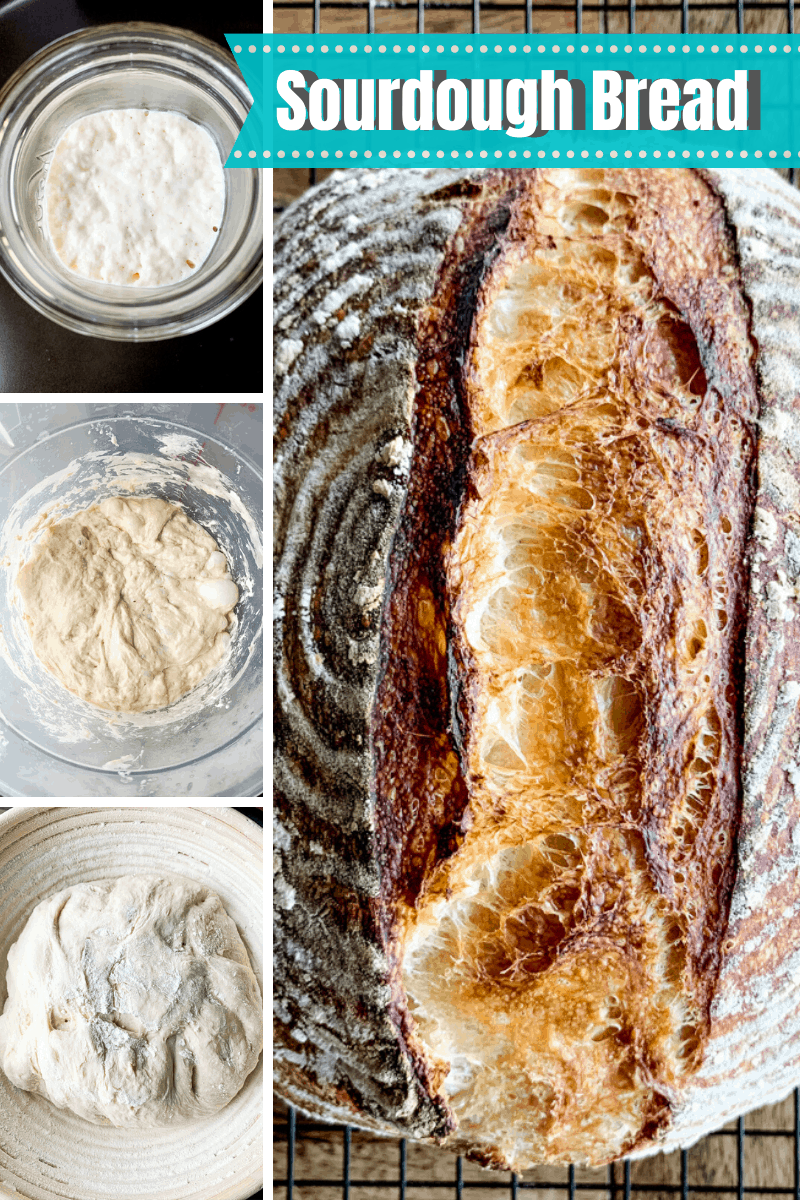
Sourdough Bread Recipe
We know many people are looking for an easy introduction to sourdough, without worrying about technique, so consider this your introductory lesson to making sourdough starter and bread from scratch. There are many methods and recipes for sourdough out there, and we are just focusing on one simple method. If you graduate from this and want to get fancy, there is a lot more to try out with sourdough baking!
The most important first step is to have a sourdough starter. You might already know someone with a starter, and if so, you’ve got an easy head start! You don’t need a lot, just get a couple of tablespoons and then immediately feed. If you aren’t lucky enough to have family or friends with an active sourdough starter, you can make your own from flour, water, and a bit of patience.
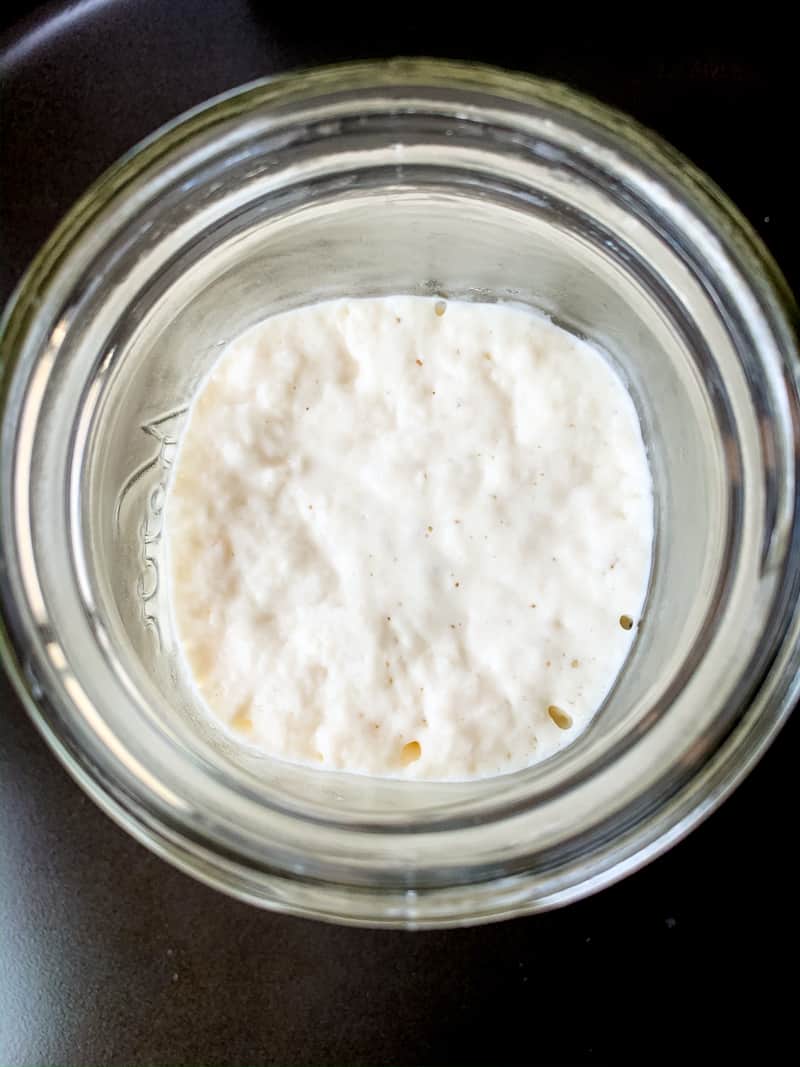
How to Make Your Own Sourdough Starter:
Wild yeast lives in the air and flour, it’s everywhere really! Breads made from wild yeast do not require commercial yeast. To make your own wild yeast sourdough starter
- Fill a larger plastic or glass container with 1/2 cup flour and 1/2 cup water. Stir until thoroughly combined into a smooth batter.
- Cover with a loosely screwed on lid or plastic wrap.
- “Feed” your starter 4 ounces of water and flour, stirring until combined, every 24 hours.
- Notice any air bubbles day to day, both large and small, that means it’s working and the wild yeasts are doubling! It should start to smell sour after a few days, but room temperature can affect how quickly it activates. Don’t worry too much about it, just keep feeding it every day. The texture will change from a pancake dough batter to an airy, lighter batter over the first 5 days.
- By day 5, or once it smells sour and is airy and doubling in volume, it is ready to use in your preferred sourdough bread recipe!
How to Maintain a Sourdough Starter
If you bake bread often, you can leave your starter on the counter and feed daily to keep it active. We like to feed 5 Tablespoons of both flour and water. You’ll find that your jar can’t contain that much starter, as it will double in size each time you feed it. You can either discard a bit of starter before each feed, or you can save it and use in waffles, pancakes, pizza dough, or even fry up that discarded starter in oil and add some seasonings as a delicious, sourdough ‘pancake!’ Just always make sure to leave at least 2 tablespoons of starter behind to continue to feed. You never want to use it all up.
If you want to only make bread once each week or less, keep your starter stored in the fridge. 2 days before you’re ready to make bread, remove it from the fridge and feed and leave on the counter. 24 hours later, feed it again. It could take anywhere from 2-5 hours for the starter to be fully active and ready to use after that second feed. Once it is fully active and doubled in size, you are ready to bake. Make sure to feed your starter after each discard or use.
Using Your Sourdough Starter: Making the Dough
Now that your starter has doubled in size and is billowing at the top, you are ready to make your bread dough. We like a larger loaf, so mix 5 cups of flour with 2 cups of water. Either all purpose or bread flour will work, though we prefer bread flour. You can start mixing with a wooden spoon if you like, but you’ll realize pretty quickly that a spoon will only get you so far, and you’ll want to switch to just mixing by hand. The dough will be really sticky and thick. Let the dough rest for 45 minutes with a lid on or covered in plastic wrap. This resting process where gluten development begins is called the autolyse.
First Rise
After 45 minutes, add in 1 Tablespoon salt and 1/2 cup of your starter to the water/flour mixture. Mix this all in by hand until well combined, but do not knead. Let it rise for anywhere from 12-24 hours. In the winter, when the house is cooler, we let this rise for about 20 hours. In the summer, we stick fairly close to 12-14 hours. You just want it to double in size. Without adding any commercial yeast, this can be a fairly long process, so we tend to do this first rise overnight.
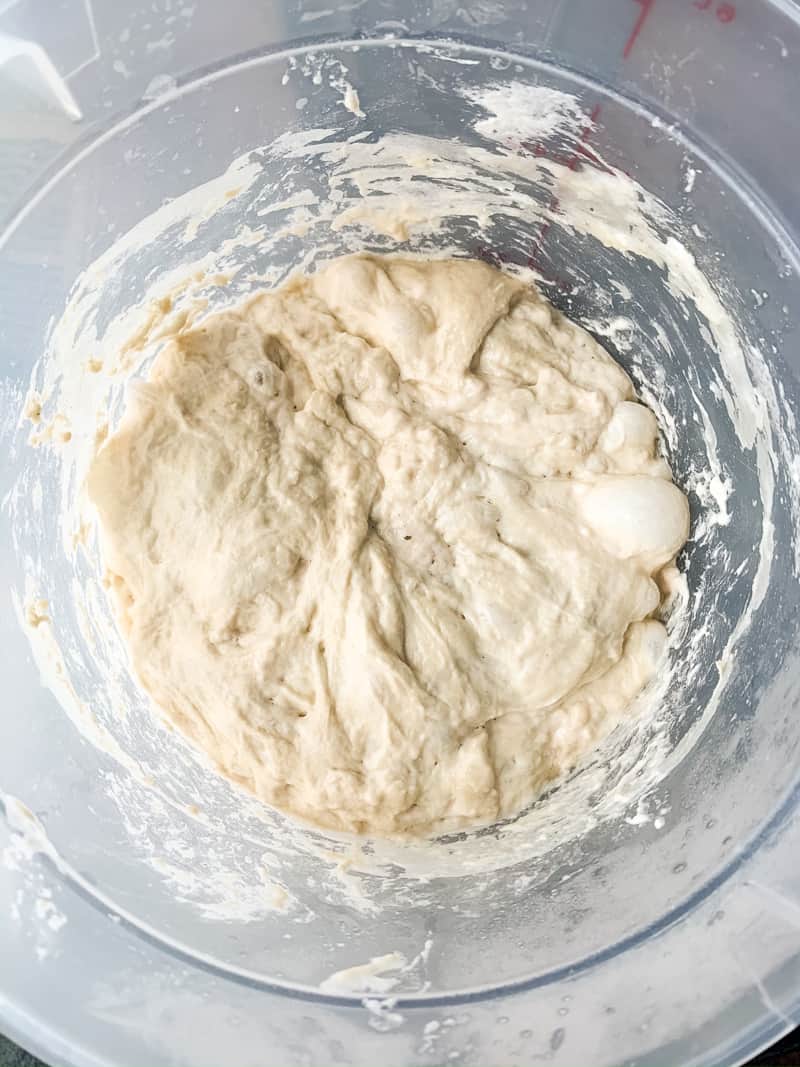
Second Rise
Once the dough has doubled in size, dump it out onto a clean, floured surface and fold it over a few times into the center. Transfer this to an oiled bowl or to a floured proofing basket. Let it rise for 3-5 hours. You’ll know it’s ready when you poke it with your finger (not too harshly) and the indent remains, or only very slowly springs back while still leaving an indent. If the dough springs right back, it needs more time to rise.
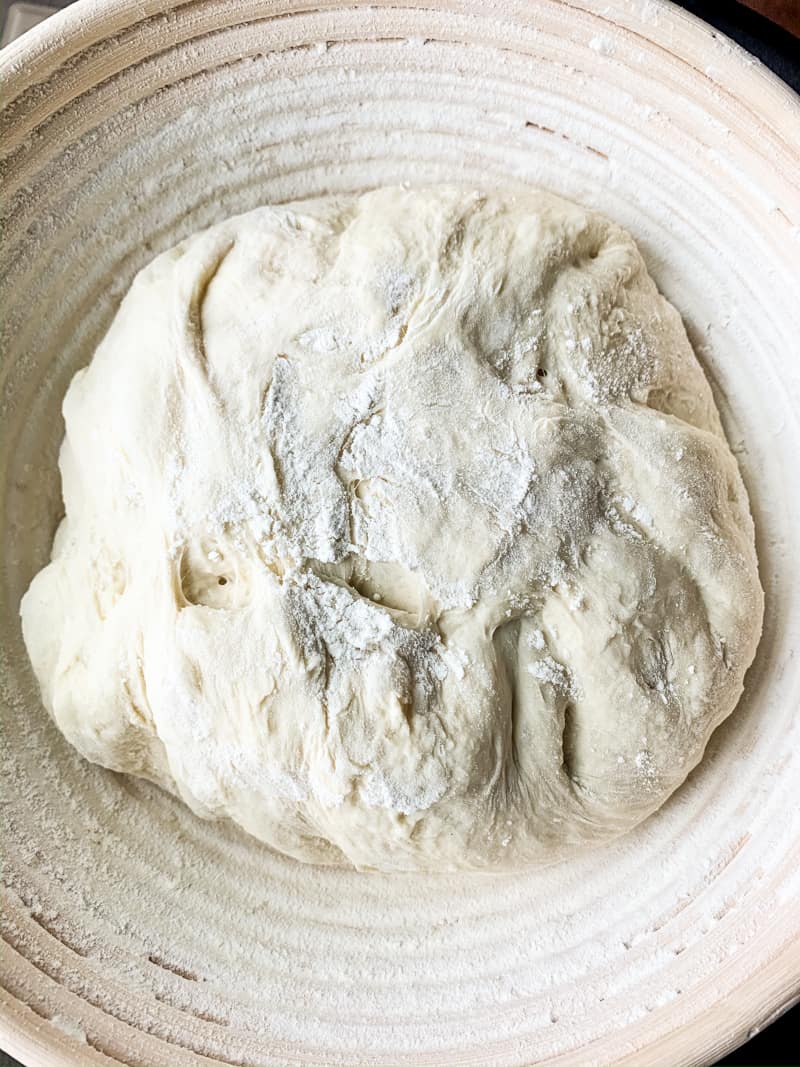
Baking Sourdough Bread
Once your dough is fully risen, preheat your oven to 450 degrees Fahrenheit with your dutch oven in the oven for the entire preheating time. Flip your dough from your basket/bowl onto a bread sling or large piece of parchment paper. Use that excess parchment paper to help lift the dough into the dutch oven. Put lid on and bake for 30 minutes. After 30 minutes, remove the lid and continue to bake until bread is a deep brown, approximately 30 more minutes.
PRO TIP: Put a baking sheet under your dutch oven when you remove the lid, and bake for the remaining time this way. This will ensure the bottom of the bread doesn’t get too dark or burn.
Once the bread is a deep brown, turn off oven and crack the door. Let your bread cool in the cracked oven for 20 minutes before removing from oven and dutch oven, and putting on a cooling rack. Cutting into a warm loaf of bread is SO tempting, but it is important to let the bread cool completely to allow texture and flavor to develop completely.
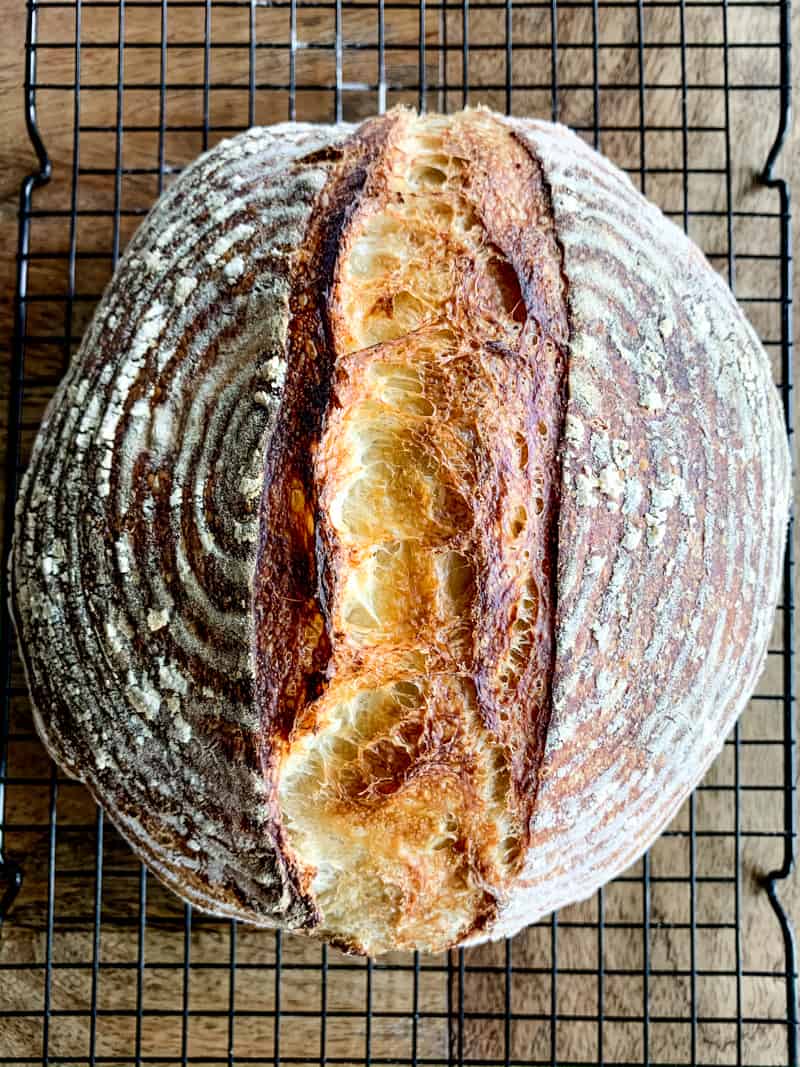
Storage Instructions for Sourdough Bread
Room Temperature Storage:
- Cool the bread completely before storing.
- Wrap the bread in a clean, dry cloth or place it in a paper bag to maintain its crust’s texture.
- Store in a cool, dry place for up to 3 days.
Refrigerator Storage:
- Not recommended, as it can dry out the bread and affect texture.
Freezer Instructions for Sourdough:
- Slice the bread if desired for easier use.
- Wrap slices or whole loaves tightly in plastic wrap or aluminum foil.
- Place wrapped bread in a freezer bag or airtight container.
- Label the bag or container with the date.
- Freeze for up to 3 months.
To Thaw:
- Leave at room temperature, wrapped, until thawed. For slices, you can toast directly from frozen for convenience.


What is a Dutch oven that goes into an oven look like?
A dutch oven is just a heavy cooking pot with a tight fitting lid. Typically they are round or oblong and cast iron or enamel coated cast iron. The most important thing is to just be sure you are using an oven safe pot.
This is my first time ever at attempting a sourdough loaf. I have got as far as the 2nd rise, however it is sticky although it has risen double again like the first rise. My question is should I add some more flour and wait for another rise before I bake it or just bake it how it is?
Many thanks, Fiona
At this point in the game, you don’t want to add anything more to it. I would bake as is. The dough will be a big more sticky than you’re used to with a traditional sandwich bread loaf, but still should not be SO sticky that it sticks to your proofing bowl for the second rise.
Thanks Rachel. It was still sticky in that it stuck to my finger when pressed to test for spring, but because I lightly oiled the bowl it didn’t stick to the bowl. It’s now morning here so I am baking it now. I’ll let you know how it turns out.
As a point to note, i used your measures for the starter, but halved the measures for the loaf. This is because I don’t have a dutch oven but only a cake tin, so kept the size smaller than yours so as to fit the cake tin. I have covered with tin foil, as I have no lid. We’ll see how it turns out.
I have kept my starter in the fridge, so when I try this again, would it be best if I followed your measurements (maybe halving again) but then adding more flour to get to the correct consistency for the first rise?
I have a Panasonic SD-257 (quite old) breadmaker but it doesn’t have a program for sourdough baking. The container is probably ideal with the lid and heat etc.
Rachel, i assume your Dutch oven is round but the bread is oblong so I’m a little confused. I have a Lodge Dutch oven but it’s round. Just doesn’t seem like that would work.
My dutch oven is oblong, but you can always use a round one!
I made this and I think it came out too sour. Do you have any ideas what I may have done wrong?
Thanks!!
Some people prefer a stronger sourdough flavor, and others like it more mild. You can always experiment with how much sourdough starter you add to the recipe, however, pay attention to the consistency of your dough. You may need slightly more water to compensate.
Thank you!!
Im so visual so if you ever made a step by step video or pictures that would be amazing!
Would self rising flour work? That’s all I have available
Self rising flour has salt and baking soda added to it, making it not an ideal substitute.
My starter around day 5 still is a bit watery and has a water layer on top. Not sure if this means I just need to give it more days or what I am doing wrong. I’ve been doing 4oz of water and 4oz of flour daily.
The liquid layer on top is called “hooch”. It essentially means that your starter has eaten up everything available and is hungry for more! If you are at day 5, (and I am making the assumption that there is no presence of mold and it smells sour) my recommendation is to drain off that top liquid, discard up to half of your starter (always in the trash and not down your disposal), and feed it. If 3-5 hours after that feed, it isn’t looking any more bubbly, I would move to twice/day feedings: morning and night. Always discard before you feed at this point on out (always leaving at least 2-3 Tablespoons).
I also realized and I am not sure if i misunderstood but in the original instructions you mention 1/2 cup of flour and 1/2 cup of water. Then you switch to 4oz of water and 4 oz of flour. I maintained 1/2 cup flour water and 1/2 cup flour, but 4oz of flour I am not realizing is not 1/2 cup. Is that a potential reason why my mix is off?
I tried this and my sourdough starter is very runny even after feeding, is this normal? Also my dough did not really rise much after 24 hours but only looked very runny and wet 🙁
Once your starter is at day 5 and beyond, it will take 3-5 hours after feeding for it to fully activate. It will start out looking like a pancake dough consistency, and then as time goes on will become airy, bubbly, and smell sour.
I have a sourdough starter that I grew and have been maintaining there is about a cup, would I use 1/2 cup of that starter in this recipe?
Yes, you want to use 1/2 cup for this recipe.
Confused if you bake it in the Dutch oven how does it get the shape in the picture?
The dutch oven used for this loaf was more of an oval shape. We’ve used a more circular dutch oven before and it produced a bit flatter and more circle shaped loaf.